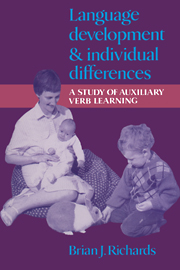Book contents
- Frontmatter
- Contents
- List of figures
- List of tables
- Preface
- Symbols used in transcription
- Pronunciation table
- PART I INTRODUCTORY SECTIONS
- PART II INDIVIDUAL DIFFERENCES AND AUXILIARY VERB LEARNING IN SEVEN CHILDREN
- PART III ENVIRONMENTAL INFLUENCES AND INDIVIDUAL DIFFERENCES IN AUXILIARY VERB LEARNING
- 10 Previous research
- 11 Yes/No questions and rate of auxiliary learning for thirty-two children
- 12 Conclusion
- Notes
- References
- Index
10 - Previous research
from PART III - ENVIRONMENTAL INFLUENCES AND INDIVIDUAL DIFFERENCES IN AUXILIARY VERB LEARNING
Published online by Cambridge University Press: 19 September 2009
- Frontmatter
- Contents
- List of figures
- List of tables
- Preface
- Symbols used in transcription
- Pronunciation table
- PART I INTRODUCTORY SECTIONS
- PART II INDIVIDUAL DIFFERENCES AND AUXILIARY VERB LEARNING IN SEVEN CHILDREN
- PART III ENVIRONMENTAL INFLUENCES AND INDIVIDUAL DIFFERENCES IN AUXILIARY VERB LEARNING
- 10 Previous research
- 11 Yes/No questions and rate of auxiliary learning for thirty-two children
- 12 Conclusion
- Notes
- References
- Index
Summary
Introduction
Since 1977 a number of correlational studies have appeared which examine relationships between linguistic input and subsequent rate of language development. These studies, which have produced conflicting results, have evoked considerable theoretical and methodological controversy. Nearly all have included a measure of the child's auxiliary verb development, and it is this aspect which appears to have given rise to one of the most consistent findings to date, namely an association between Y/Ns in input and rate of auxiliary verb learning.
It will be argued, however, that this finding is not as clear-cut as is often assumed, and it will be shown that the usual explanation for this relationship is unable to account for most of the results published. While the investigation to be described finally produces evidence consistent with current hypotheses relating to the mechanisms involved in extracting the auxiliary from input, it will be stressed that these mechanisms are far from being fully understood.
Naturalistic studies
Nine naturalistic investigations into relationships between input and subsequent rate of language development use an index of auxiliary verb development. Eight proceed from a common research paradigm and will be treated together. The ninth by Keith Nelson and his colleagues is rather different and will be considered separately. The eight are:
Newport, Gleitman and Gleitman, 1977 (NGG)
Gleitman, Newport and Gleitman, 1984 (GNG): a reanalysis of NGG.
Furrow, Nelson and Benedict, 1979 (FNB).
Barnes, Gutfreund, Satterly and Wells, 1983 (BGSW).
Hoff-Ginsberg, 1985 (HG1): the influence of discourse features and sentence type.
Hoff-Ginsberg, 1986 (HG2): structural and functional influences in the same data.
Scarborough and Wyckoff, 1986 (SW).
Yoder and Kaiser, 1989 (YK).
Information
- Type
- Chapter
- Information
- Language Development and Individual DifferencesA Study of Auxiliary Verb Learning, pp. 161 - 172Publisher: Cambridge University PressPrint publication year: 1990
